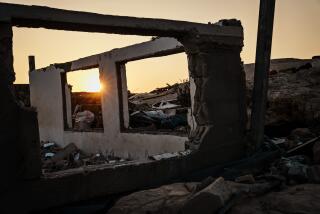Media Is the Message of Conference : Coverage: The overwhelming presence of thousands of journalists in Madrid colors what the participants say and how they behave.
- Share via
MADRID — The lobbyists actually hang out in the lobby, although it is more cavern than foyer, and they spin antagonistic versions of regional truth with silver tongues that inevitably conflict but ultimately spell out the same message.
The Palestinians are enthusiastic but disorganized amateurs, according to the conventional wisdom, while the Israelis are widely considered efficient professionals. The Soviets are conspicuous by their absence. It is the Americans, seen and unseen, who underlie the drama unfolding here in Madrid.
The target of them all is a gargantuan international media corps that has become, de facto, more player than observer. Its overwhelming presence colors what all the principals say and how they behave. However serious any of the delegates may be about building peace, all of them see their historic encounter in Madrid as an unparalleled chance for salesmanship: Believe Us Most.
The Spanish government says about 4,500 journalists have come for the conference; about 2,500 are resident in Spain and the rest elsewhere. There are nearly 1,000 Americans.
A newsstand at the press center may be the busiest in Spain. Name it, they sell it: Japan’s Nikkei Weekly, Belgium’s Het Laatste Nieuws, Penthouse in Spanish.
As the conference began, Spanish officials responsible for logistics were unable to say how much it would cost to accommodate the media battalions or who was paying for it. At the booth for the “core group” of officials responsible for the care and feeding of the media, they now speak no Spanish--just American.
The press center is in a giant exposition hall in a disused fairgrounds not far from the Royal Palace peace conference site--and the Madrid Zoo. It is overflowing with briefers, leakers and truth tailors of rainbowed array. They cast tea leaves and interpret them to suit the needs, nationality, politics, deadlines and gullibility of their questioners.
In a frenetic week, they have initiated reporters to the intricacies of the Equal Time Alarm (how long each delegation would be permitted to address the conference), the Handshake Handicap (whether Israelis and Arabs could, would, should or did shake hands) and the Next Venue Crisis (where the second round of talks will take place).
Only a relative handful of reporters actually get into the palace for conference sessions. For the rest, giant television screens are hung on the second floor of the exhibition hall in a press working area, where each of the 738 seats has its lamp and a bulky, dinosaur typewriter. Many of these, including 30 with Arabic type and 30 with Hebrew type, quickly went from table to floor, victims of the laptop computer revolution.
The basement level is dominated by the football-field-sized cubicles of the four American television networks and the smaller, temporary Madrid bureaus of international news agencies and major papers.
It is on the lobby level where news is made--and shaped. Delegations hold news conferences in a large auditorium there; the lobbyists hunt, amid heavy security, a bank that offers the best exchange rates in town and an inexhaustible supply of thin sandwiches, stale coffee and hungry reporters.
Mideast delegations all have press offices on the lobby floor supported by pamphlet barrages. The Americans are crisply there, too, behind a sign that warns: “Safety First. Positively No Smoking.” U.S. information knows no frontiers: For those already boned up on matters Mideast, there are also Agriculture Department ideas on improving poultry production in the Soviet Union.
The Soviets, nominally the conference co-hosts, are next door. But nobody’s home. The last Russian out is said to have been sighted Wednesday, pleading with his embassy in Madrid to fax him--in any language--a text of the speech that Soviet President Mikhail S. Gorbachev had delivered to the conference hours before.
The Israelis, whose office boasts a color computer, a television and a polyglot staff, jumped off to an early lead in the conference brochure war with a preemptive strike of slick charts and background papers.
The Jordanians rallied with a handsome fact book. The Palestinians joined the fray belatedly, then with hard-core propaganda, including one speech identifying Palestine Liberation Organization chief Yasser Arafat as president of the State of Palestine, which, according to the conference, does not exist.
The Palestinians at Madrid, relative newcomers to diplomacy at its highest and headiest level, host a press center office that has the noise, the throngs, the one-day-soon-we-gotta-get-organized feel--and the homey charm--of a Middle East bazaar.
Israeli efficiency and Palestinian enthusiasm spill out of the press center to the hotels of separate-but-equal standard where the two delegations stay in Madrid.
The Israeli hotel, which has gold wallpaper and offers el brunch de la paz , swarms with well-informed, persuasive press briefers. Israel’s infinitely available deputy foreign minister, Benyamin Netanyahu, has elevated the 12-second homogenized sound bite to an art form.
The Palestinians say the security at their hotel, an old bullfighters’ inn, is insufficient to allow them to receive reporters there, but the flow of people and prismed news within is impressive nevertheless.
At one point, four different Palestinians claimed to be their delegation’s press spokesman. The confusion was moot because the Palestinians’ press phone numbers didn’t work.
More to Read
Sign up for Essential California
The most important California stories and recommendations in your inbox every morning.
You may occasionally receive promotional content from the Los Angeles Times.













